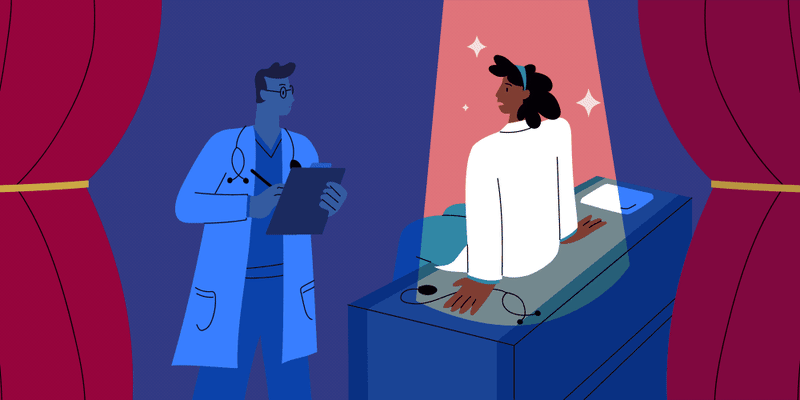He was intubated and deeply sedated, hypoxemic from multifocal pneumonia, and on two vasopressors for his septic shock. Another gentleman was cachectic, and barely able to walk to the bathroom on his own due to extensive left lower extremity pyomyostitis. Yet another patient experienced acute respiratory failure from Legionella pneumonia, and required 8 liters of oxygen. There was also the frail young man, just a few years older than I, on inotropic support for decompensated heart failure. And I can’t forget the elderly patient’s grunts and groans, dementia limiting his ability to tell us where he was hurting.
I recognize that it is reductive to condense these patients into a single sentence about their most acute pathologies, but a reductive sentence is what unites these men. Incarceration has shaped the lives of the patients I described in ways that profoundly impact their health and their experience of health care. Each man presented to the hospital in the custody of carceral guards, who would remain within a radius of about 10 feet for the entirety of their hospitalization. These patients would then spend the vast majority of their time in the hospital shackled to their beds, the cold steel of the cuff linking a wrist or ankle to the bed where they lie.
Discretion regarding restraint of patients experiencing incarceration is determined by the policies of the carceral facility from which patients present. These policies are often indiscriminate – applied to patients sentenced for both violent and nonviolent crimes; to patients admitted to general wards as well as to those in intensive care settings; to those being treated with curative intent and unfortunately, sometimes even to patients who are found to have terminal illnesses or transitioned to palliative measures. While at least 37 states protect pregnant people in labor from the dangers of shackling during childbirth, vague language surrounding exceptions may mean that babies are born to mothers chained to their beds.
Harms from shackling practices have been previously summarized in medical literature – noting direct and indirect impacts on a patient’s physical and psychological well-being. Direct harms from shackles can occur if a steel cuff is overly tightened around a restricted limb, potentially leading to pressure injuries to the skin and soft tissue, compressive neuropathies, or fractures. For patients in labor, restricted movement can make it more difficult to make position changes, which increases risk to mother and fetus. Indirect harms from shackling may include worsened deconditioning due to restriction of movement, increased risk of venous thromboembolism, and heightened bias among health care workers responsible for patient care. I worry that the biases incarcerated patients experience while shackled contribute to psychological traumas that may lead to further distrust and health care avoidance.
The stated purposes of shackles in patient care settings are not significantly different from medical restraints – namely, they exist to prevent elopement, impede movement, and decrease risk of harm to self or others. Medical restraint policies, however, are federally mandated to be used to the least restrictive degree possible, and are to be initiated in response to agitated or combative behavior. Shackling, on the other hand, is more physically restrictive and is less formally restricted by government policies, resulting in almost universal application for each forensic patient that enters the hospital. While I am a staunch advocate for the safety of health care workers, I believe it is important to recognize that universal shackling is a policy born of fear – a fear that strips patients of their rights, and likely contributes to worse care in a population already at significantly increased risk of early mortality.
Academic discourse about the rights of patients involved in the justice system continues to be the primary locus of idea sharing about care for patients experiencing incarceration. While such discourse is critical to raise awareness and consider what more just care should look like, advocacy has rarely extended into policy space, or even into formal education of trainees. It’s hard to advocate for patients when you aren’t sure what their rights are, or what you can do to ensure they are respected. In order to bring such conversations to the policy space, we must partner with organizations made up of and primarily built to serve individuals with justice system involvement.
The policy changes for patients involved with the justice system are not likely to be achieved quickly. As health care workers continue to learn more about the rights of incarcerated patients and advocate for changes, it is also critical that we educate our teams about how to provide the best care for the patients in front of us. Actions such as requesting the removal of the shackle to perform a complete physical examination, or providing strict activity orders that may help facilitate movement and avoid deconditioning while in the hospital may be helpful in the short term. The complexities of care for individuals experiencing incarceration must be formally considered and consistently applied.
I know that the care that I have provided to incarcerated patients has been impacted by the presence of shackling. My initial exam on the gentleman with pyomyositis was limited by the shackle on his leg. I didn’t know I could ask for his shackle to be removed. This incomplete exam may have delayed the placement of an additional drain to achieve source control of his infection. The elderly gentleman groaning in pain just needed to be able to reposition himself more comfortably, which he couldn’t do until the shackle was removed. The gentleman with Legionella pneumonia had mentioned that coming into the hospital meant even more restrictions on his life than what he experienced at his correctional facility – at least there he could freely move around his room, and was entitled to one hour of exercise outside of his cell every day.
Restrictive policies and physical restrictions, most concretely evident in shackling, put patients who are incarcerated at risk for poorer health outcomes. Our patients do not have time to wait for more academic discourse. For each year an incarcerated individual serves in prison, that person’s life expectancy declines by two years. Indeed, the link between poor health and incarceration is as tangible as the cold steel that tethers our patients’ bodies to their beds.
What are your thoughts on shackling policies? Share in the comments.
Dr. Michaela C. Barry is a third-year internal medicine resident and aspiring infectious disease fellow currently living in Pennsylvania. She credits her medical school and residency communities for helping develop the thoughts she shares here. Dr. Barry is a 2023–2024 Doximity Op-Med Fellow.
With gratitude to Dr. Jaime Meyer, Dr. Amar Bansal, Dr. Ben Zuchelkowski, the University of Rochester Department of Bioethics, URSMD Health-Incarceration Connection, and Brendan Barry JD for their engaging conversations and discourse on this topic.
All names and identifying information have been modified to protect patient privacy
Image: LightField Studios / shutterstock







